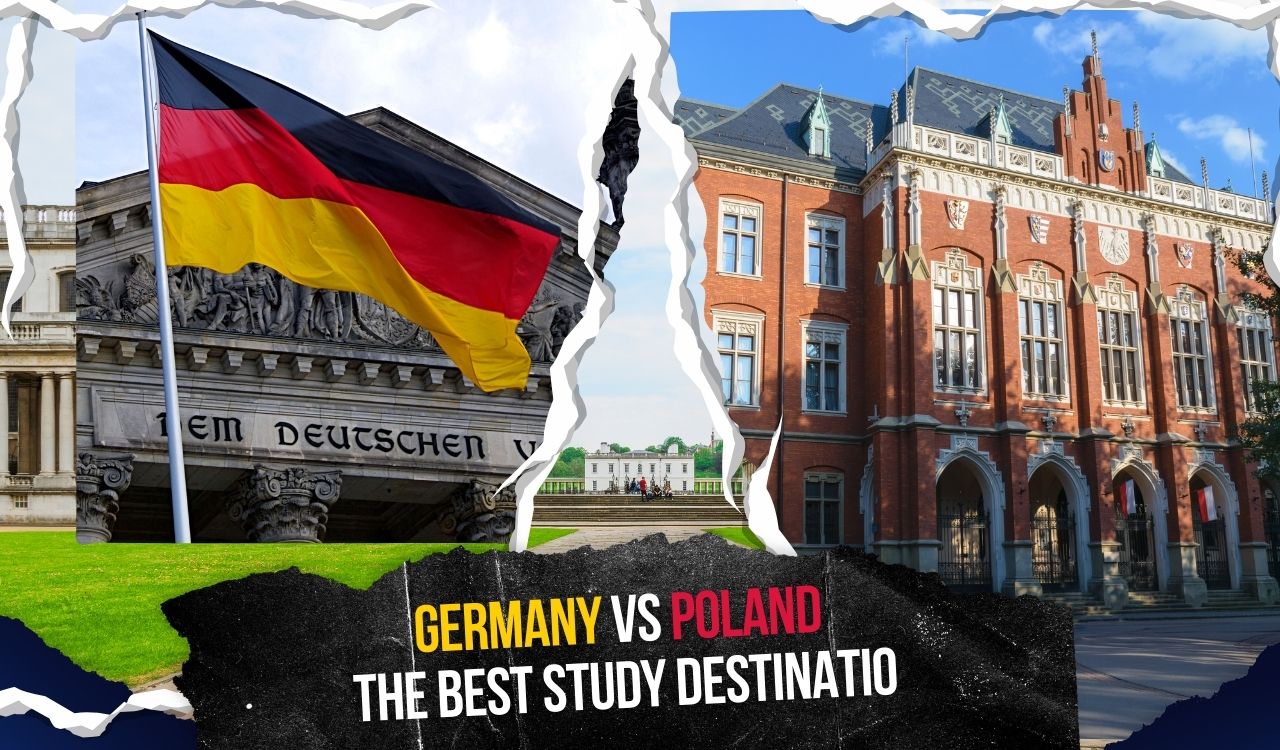Germany vs. Poland: Best Destination for International Students in 2025
Since international education quickly becomes competitive in 2025, Europe is still a top goal. Among the most popular options, Germany and Poland attract thousands of students each year. Both provide high -quality education, strength and rich cultural experiences.
However, when comparing study in Germany vs Poland, there are significant differences that can affect your academic journey, lifestyle and the opportunities for career. We offer a complete international student comparison to help you decide which is the best European country to study in 2025 based on factors like education quality, cost of living, language, and job opportunities.
Education System Overview
The education system defines your educational experience and the global recognition of your degree. Here we find out how Germany and Poland support their higher education and international students.
Germany: Structured, Research-Oriented, and Prestigious
Germany offers over 400 public universities, many of which are ranked globally. Known for its research-intensive programs, especially in engineering, technology and science, the country emphasizes academic excellence and innovation. Most public universities provide tuition-free education, making Germany extremely attractive to students. Institutions such as TU Munich, University of Heidelberg and LMU Munich offer English-taught programs alongside access to world-class research facilities and industry connections. It’s no surprise that when students weigh up study in Germany vs Poland, Germany often stands out for its strong academic reputation.
Poland: Modern, Flexible, and Growing in Reputation
Poland's education system is in line with the European area for higher education, which offers a wide range of English-taught programs. Polish universities receive international recognition for areas such as medicine, business and engineering. Top institutions such as Jagiellonian University and Warsaw University are quickly climbing global rankings.
The academic approach is student-centric, focusing on innovation, international collaboration and practical skills. Poland is becoming a smart alternative for students seeking high-quality education in Europe, and is often included in discussions on the best European country to study in 2025.
Cost of Tuition and Living
Where to study, power plays an important role in choosing. This section compares tuition fees and daily life expenses for international students in Germany and Poland.
Germany: Tuition-Free but Higher Living Costs
Germany provides teaching -free education at most public universities, and requires only about € 250- € 350 semester contributions. However, the costs of living may be relatively high, especially in cities such as Munich and Frankfurt, where monthly expenses can reach € 1100. Scholarships such as DAAD and Erasmus+ are available to support international students. The country provides excellent infrastructure, public transport and health services, and justifies high lifetime costs.
Poland: Affordable Tuition and Low Daily Expenses
Poland is one of the most affordable sites in Europe. The annual teaching ranges from € 2000 to € 4000 to much lower than Western Europe. Monthly living costs average € 500 to € 750, including housing, food and transport. Cities such as Cracko, Lubels and Vrocala offer high standards of living for a fraction of costs. The scholarships for government-funded and university levels are widely available by the government, which is ideal for Poland-budget conscious international students.
Language and Communication
Language affects your educational success and daily life. Both countries offer English programs, but the knowledge of the local language can be valuable
Germany: English Programs with German Integration
Germany offers many English-taught master programs, especially in technical and scientific fields. However, skills in German are often crucial to administrative functions, internships and employment. Most universities offer language courses to help students adapt. While English is widely spoken in academic surroundings, local culture often requires the least basic German skills to integrate.
Poland: English-Friendly with Local Hospitality
Poland quickly becomes English -friendly, especially in universities and urban areas. Many student and doctoral programs are introduced in English, and Polish cities have a strong international student community. Daily life can be managed without Polish, although it is recommended to learn the basics of deep cultural specialization. Small Poles often speak English fluently and make communication smooth for international students.
Work Opportunities for Students
Working during and after your studies can shape your financial stability and future career. This section explores student work rights and post-graduation options.
Germany: Strong Employment Prospects and Work Rights
International students in Germany are allowed to work 120 full or 240 half a day per year. There is a strong economy in the country with high demand for graduates in engineering, IT and research fields. After graduation, students can apply for an 18-month job visa to find work. Floating in German improves full -time roles and access to high wages. Germany provides one of the strongest career paths for international graduates in Europe.
Poland: Growing Job Market and Simple Rules
In Poland, international students can work part -time without their own permission. After completing their studies, they can apply for a temporary residence permit to apply for work. The job market is growing in areas such as outsourcing technology, finance and business processes. Large cities host multinational companies where English is enough for the role of entry level. While the alternatives after the study are not as long as Germany, Poland still provides a viable passage for career development.
Student Life and Integration
Your lifestyle, social environment and integration into society are important for your personal development. What to expect in both countries here.
Germany: International, Organized, and Urban
Germany provides a structured but lively student life. Cities such as Berlin, Cologne and Stuttgart are multicultural hubs with diverse populations. Public transport is reliable, and universities offer excellent student services. Students benefit from cultural festivals, education clubs and global networking opportunities. Organized systems in Germany ensure a steady integration for international students in search of both educational and cultural enrichment.
Poland: Vibrant, Affordable, and Student-Focused
Poland provides a warm, inclusive environment for international students. Cities such as Warsaw, Crocaco and Posing have an active student community, exciting nightlife and a rich historical heritage. The low cost of living allows students to enjoy travel, food and cultural programs without financial stress. Many universities have dedicated student aid centers, and help new people to adjust to life easily in Poland.
Visa and Immigration Process
Understanding visa requirements is essential before making your move. Let’s look at how both countries handle student visas and immigration procedures.
Germany: Structured Process with Long-Term Options
To study in Germany, students require €11,208 in a blocked account to cover the visa of de-type, proof of entry, health insurance and expenses. While the application process is structured, it may take time. After graduation, students can apply for an 18-month job-wasted visa, making Germany attractive for a long-term career plan.
Poland: Easier Entry and Lower Financial Requirements
Poland requires a national de -visa or temporary residence permit with easy financial documentation compared to Germany. Visa agreements are easy to obtain, and students can work legally during studies. After graduation, international students can apply for a temporary residence permit and look for jobs. Poland's flexible immigration policy makes it an available option for many people.
Conclusion
In the developed scenario with global education, both Germany and Poland stand as a unique alternative for international students in 2025. If your priority is the benefits of world -class education, research opportunities and after -study work, Germany will probably be the best option.
On the other hand, if you are looking for more financial, inviting and culturally engrossing experience, Poland is a great alternative. The real answer in the study in Germany vs Poland debate depends on your education goals, financial status and personal priorities. Compared to this broad international student, both countries provide unique benefits, making a strong challenger for the best European country to study in 2025. Think Europe, we specialize in guiding students like you for the best decisions for your future. Whether you bend to Germany's structured skill or dynamic, reasonable opportunities in Poland, our expert advisors are here to help you at each stage.

